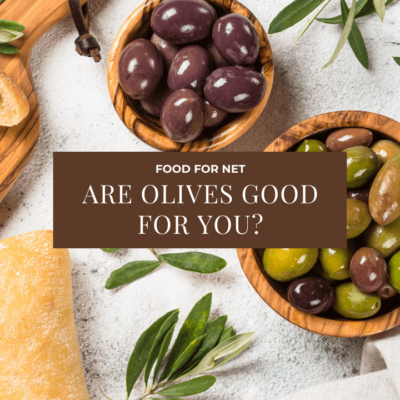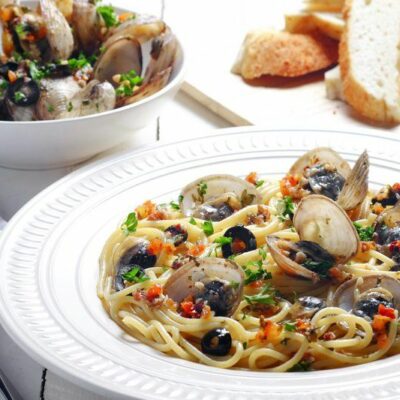
Olives are a famous part of the Mediterranean diet and a source of powerful heart healthy compounds. Yet, you never see them sold raw in the grocery store. They’re typically sold in a salty brine instead.
So, what’s the story? Can you eat raw olives? And, if so, are there benefits to eating them raw?
The short answer is yes, you can eat raw olives – in theory, anyway. Basically, raw olives aren’t dangerous; they’re just intensely bitter.
The bitterness comes from a compound called oleuropein and it sticks around. Seriously. You might be trying to get the taste out of your mouth for hours and still remember it with disgust months or even years later.
That’s not all. Raw olives also tend to be much firmer than cured olives, with a tough and unpleasant texture. Even if you could tolerate them (which is a big ask!), there’s little benefit to doing so, as most of the compounds and healthy fats in olives survive the curing process.
As a result, cured olives offer all the health benefits of uncured olive, with a better texture and much less bitterness.
P.S. Raw olives are a little like raw pasta. Both ingredients have minimal risk when eaten raw, but doing so still isn’t a great idea.
Can You Eat Raw Olives?

Eating a raw olive isn’t likely to cause harm. Still, their bitterness and texture means they’re effectively inedible. You’re only likely to eat them raw as part of a bet or perhaps when you’re very drunk.
The main exception is that olive growers may sometimes eat a raw olive, to give them some sense of their harvest. They then need to chew the olive for long enough for the bitterness to pass, after which point some sweetness and flavor can be tasted.
Even here, olive growers are likely to choose the ripest possible olives, as these are a little less bitter (although, they’re still pretty awful).
The Problems With Raw Olives
The big issues with raw olives are their flavor and their texture, which make the fruit a truly unpleasant experience. Curing is required to get around these issues.
Beyond these, there’s the chance of digestive discomfort from consuming too much oleuropein. This is most likely if you consume a decent number of raw olives, so most people won’t run into the problem.
I mean, even a single olive is difficult to get down. Can you imagine trying to eat a few dozen of them?
Do Raw Olives Offer Any Benefits?
Raw olives do contain healthy fats, fiber, and antioxidants, all of which can promote health. However, you get those same beneficial components with cured olives too, so they’re not a reason to eat raw olives.
Beyond that, there’s the oleuropein itself. This antioxidant has been linked to decreased blood pressure and inflammation, making it highly relevant for health. Much of the oleuropein is lost during curing, so you do lose these potential benefits.
Still… oleuropein is hardly unique here. There are many other powerful plant-based compounds with antioxidant and anti-inflammatory properties. You can easily add some of these to your diet rather than trying to eat raw olives.
The only other factor is salt. Olives are often cured in salt, which isn’t good for your sodium intake. In contrast, raw olives don’t rely on salt and are naturally low in sodium.
Here too, there are options. You can look for low sodium olives, which may have been cured in water instead of a salt brine. It’s also possible to dry olives instead of curing them. That process doesn’t rely on salt, making it better for heart health./
Or, you could simply turn to olive oil, which gives you all the benefits of olives with very little sodium.
Raw Olives Vs Cured Olives

When we talk about raw food, we’re normally comparing it to the cooked version. But, with olives, we’re more interested in the differences between raw olives and cured ones. Cured olives are the ones you find in the grocery store. They can be eaten as-is, used in a recipe, or even cooked.
Curing generally involves soaking olives for an extended period, during which the water-soluble oleuropein leaches out. The process softens the olives, making them much less bitter and much more enjoyable.
The exact flavor and texture vary depending on the curing technique used and the type of olives. Some end up being buttery and soft, while others are chewy instead.
How Olives Are Processed
Brining, water curing, and lye are the three main approaches used to cure olives, although there are also some less common ones.
Beyond this, there are variations in the techniques. For example, brining and water curing generally involve regularly changing the liquid around the olives. But, a few recipes skip this and use the same liquid the entire time.
You can also choose whether to leave the olives whole, cut them in half, slit them, or smash them. Smashed or halved olives cure quickly, but might not look as you want them to.
Brining
Brining involves soaking olives in a saltwater solution that’s changed regularly. This approach is often used for black and dark purple olives.
The exact time varies depending on the strength of the brine and whether the olives have been halved, cut, or left whole. Tasting the olives is the easiest way to know when they’ve been in the brine long enough and are ready to eat. However, you’re often looking at somewhere between three and six months of brining time.
Olives cured in this way have a complex flavor, as the brine intensifies the flavors of the olive itself. There’s also some sweetness from the olive and saltiness from the brine, creating a delicious sweet-salty contrast. The olives can also be very salty, so it’s worth rinsing them before use.
Water Curing
For this approach, olives are soaked in a water bath, rinsed, and soaked again. The water needs to be changed every day for a week or more. It’s basically the same process as brining, except that you’re using straight water rather than a salt brine.
Curing olives like this can be very straightforward. It’s even easier if you choose a container with a tap at the bottom, like some coolers, so you can drain the water without any straining. However, water curing doesn’t remove as much oleuropein as other approaches, so the olives retain some bitter notes.
Some people use a combination of brining and water curing. This is the best of both worlds, as the brine adds flavor to the olives and further reduces the bitterness.
Lye Curing

Lye is highly corrosive and concerning, making it an unexpected ingredient in the kitchen. Yet, when used safely, lye can be an excellent way to cure olives.
In particular, lye curing is faster than other techniques and produces consistent results. This makes it powerful for commercial operations, and companies quickly develop procedures to ensure safety and a high quality product.
Lye curing is much less common at home, partly due to the dangers of lye. The flavor profile of lye cured olives isn’t as impressive as brine cured olives anyway, so many people stick with brine curing instead.
Fermented Olives
You can also ferment olives. This is a slow process, as you may need to leave the olives in a concentrated salt brine for a year or so for the fermentation to complete.
However, it’s also a simple approach, as you don’t need to change the liquid. It’s a great option if you have plenty of olives and don’t want to change the water regularly.
Dry Salted Olives
The dry salting technique works best with small olives, like kalamatas, and simply involves creating layers of olives and salt within a jar.
You don’t need to change the salt regularly, but the jar should be shaken and turned every day or so to keep the process ticking along. The olives will become a little shrunken as they cure and release some liquid, which then creates a slushy mix in the jar.
After three weeks or so, the olives may be ready to eat. They should taste salty and somewhat sweet, without the intense bitterness of raw olives. If they’re not there yet, leave them in the salt for longer.
Dried Olives
Thus far, we’ve been saying that you can’t eat olives raw. That’s true, but there is one slight exception to the rule – dried olives.
Notably, if olives have been dried well enough, you may be able to eat them raw without any further processing. The video below explains what you can expect and shows the level of drying you need.
For this to work well, the olives must be very well dried with no obvious fleshy parts remaining.
The video creator from above harvests her olives when they’re starting to dry and does the rest of the drying in bowls in the sun. She takes that approach because any olives left on the tree would be eaten by birds before being fully dried. Using a dehydrator would work as well.
Benefits Of Cured Olives
Like olive oil, olives are famous for their health benefits. They’re a rich source of healthy fats, antioxidants, and other powerful plant-based compounds. Even the oleuropein may offer some health benefits and a small amount may survive the brining process.
The compounds in olives are thought to have a variety of positive health impacts, including raising the level of healthy HDL cholesterol, improving blood pressure, decreasing inflammation, and decreasing the risk of some diseases.
Plus, olives are frequently eaten in Mediterranean countries and Mediterranean eating has been consistently linked to improved health.
The main limitation is the salt content, which can be high if the olives were cured in brine. This can have some negative effects, like raising your blood pressure and increasing heart disease risk. Rinsing the olives before eating them helps with this issue. You can also stick olives cured in water rather than salt brine.
Types Of Olives

It’s easy to just focus on black olives, green olives, and stuffed olives. Yet, there are actually many different varieties, many of which have exciting flavors. Here’s a small selection to get you started.
- Kalamata olives. These famous olives are named after the city of Kalamata in Greece. They’re oval, dark brown, with a distinctive meaty texture. The olives are often processed with water or brine, which contributes to their flavor.
- Castelvetrano olives. These are a great entry level olive, as they have a mild flavor and are somewhat buttery. Light green castelvetrano olives are the most authentic. Some brands sell bright green versions instead, where dye has been added to make the olives look more exciting.
- Manzanilla olives. These green olives are incredibly common and are used for olive oil and as table olives. The flavor is relatively mild, so they work well in many recipes and situations.
- Niçoise olives. These small purple olives come from France, near the city of Nice. The term refers not just to the olives, but also to how they have been cured in brine. Seasonings are often used in the curing process, which gives the olives a distinct and delicious flavor.
- Liguria olives. These olives are small and firm, with a complex flavor profile and some nutty notes.
Also, most types of olives go from green to black as they ripen, making black olives simply a riper version of the same fruit (there are a few exceptions, as always).
Despite this, some of the black olives you see in the store aren’t naturally black. They’ve been turned black through specific processing steps, ones that alter their flavor as well. This is particularly true for the black olives sold in cans and often served on pizza.
Frequently Asked Questions
Can You Eat Olives Straight From The Jar?
Yes. Olives in the jar are cured, so they’re safe to eat as-is. They’ll also taste much better than raw olives.
Can You Freeze Olives?
Freezing olives is an excellent way to extend their shelf life. It’s best to drain the liquid first, to reduce the risk of freezer burn. While olives are still good after freezing, their texture changes and they become mushier.
Can You Cook Olives?
While olives are often used in recipes, they can also be cooked. Roasting, baking, and pan frying are viable options. These have different effects on the texture and flavor profile of olives.
How Long Do Raw Olives Last?
Raw olives don’t last long at all. They won’t last longer than a week or two, if unprocessed, perhaps less. They need to be cured to last longer than this.
Can You Cure Olives Yourself?
Curing olives at home is safe and a common practice. There are many recipes online that highlight each step of the process. The hardest part is accessing fresh olives, as these are rarely sold in stores.
Some care is needed when curing olives. For example, you still need to follow conventional food hygiene practices like sterilizing jars. You should also check each olive carefully before curing to make sure it isn’t damaged and hasn’t been home to an insect.









 The Best Substitutes For Powdered Milk
The Best Substitutes For Powdered Milk